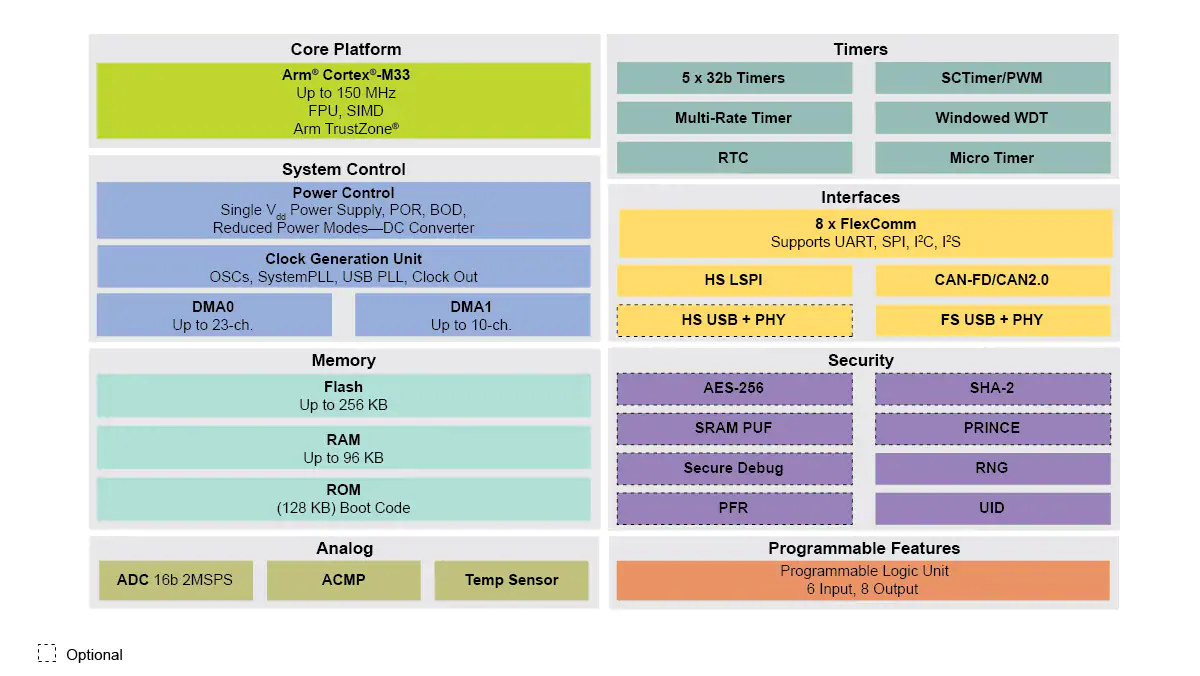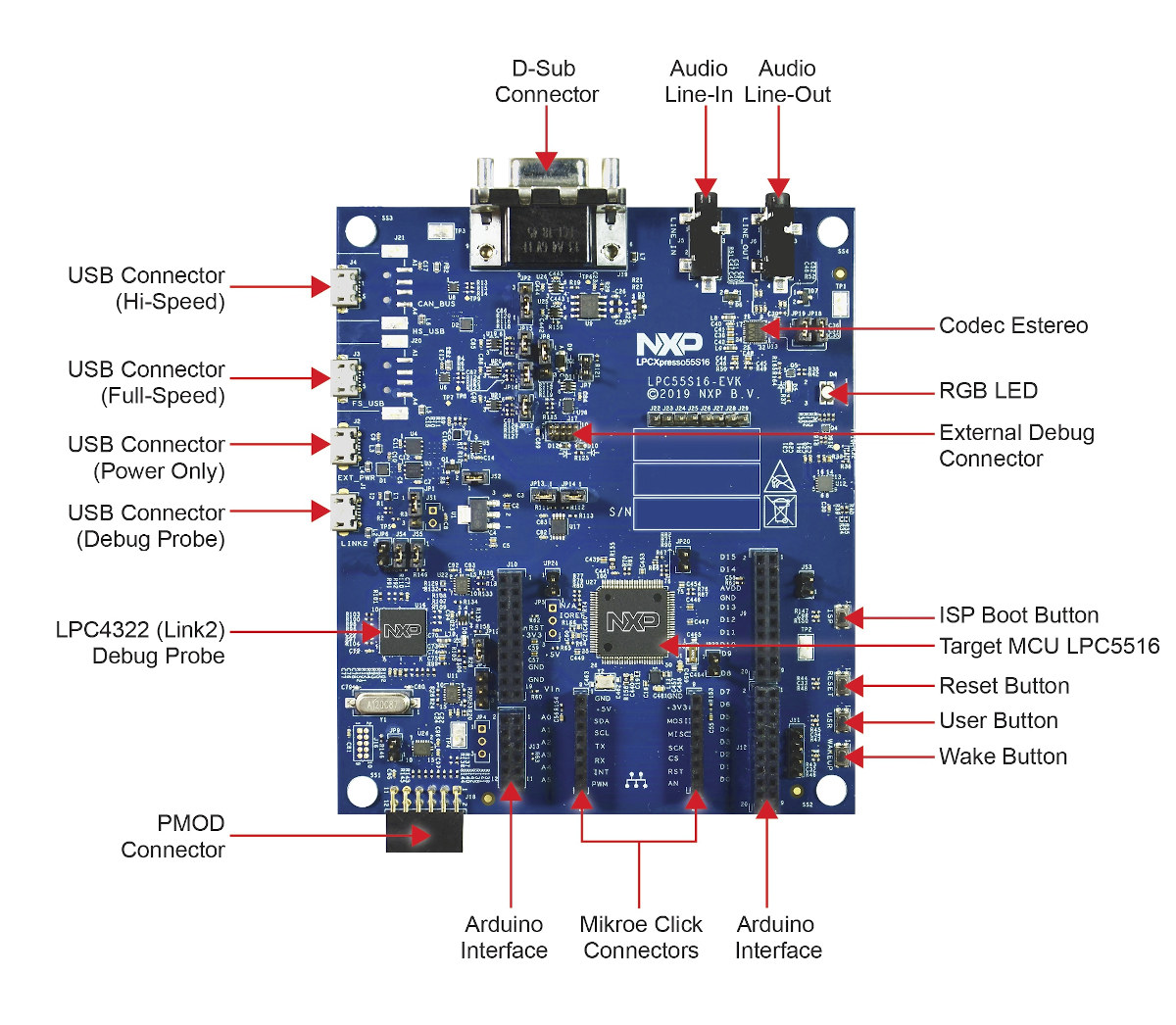NXP has announced the general availability of LPC551x/S1x Arm Cortex-M33 MCU family with low power consumption, embedded security, pin-, software- and peripheral-compatibility.
The LPC551x/S1x family is manufactured using a cost-effective 40-nm NVM process technology and targets industrial and general embedded markets. An LPC55S16 based development board – PLC55S16-EVK – is also offered for evaluation and software development.
NXP LPC551x/S1x MCU

Key features and specifications:
- CPU – Arm Cortex-M33 core @ up to 150 MHz delivering over 600 EEMBC CoreMarks and consuming as low as 32uA/MHz
- Memory and Storage – Up to 256 KB on-chip flash; up to 96 KB SRAM; 128 KB boot ROM
- Peripherals
- CAN FD / CAN 2.0
- Dual-USB with on-chip PHY, supporting both HS and FS modes
SDIO andup to 9 FlexComm interfaces (configurable as either SPI/I2C/I2S, UART)- Up to 64x GPIO pins
- 16-bit ADC with five differential channel pair
- Comparator with five input pins and external or internal reference voltage
- Timers – 5x 32-bit standard general-purpose timers, 1x SCTimer/PWM with 8 input and 10 output functions, RTC with 1 s resolution, 24-bit timer (MRT) for repetitive interrupt generation, watchdog timer (WWDT), micro-tick timer, 42-bit free-running OS Timer
- Security (S1x MCU family only)
- SRAM PUF based device root key with added application key storage options
- Secure boot and anti-rollback protection
- Arm TrustZone technology
- Hardware block cipher (PRINCE) for encryption/decryption of internal flash
- Accelerators for symmetric and asymmetric cryptography
- Authenticated debug capabilities
- Power Management
- Integrated Power Management Unit (PMU) to minimize power consumption
- Reduced power modes – Sleep, deep-sleep with RAM retention, power-down with RAM retention and CPU0 retention, and deep power-down with RAM retention
- The Micro-Tick Timer and the RTC can be used to wake up the device from sleep and deep-sleep modes
- Power-On Reset (POR) and Brown-Out-Detectors (BOD)
- Single Power Supply – 1.8 to 3.6V DC
- Temperature Range – -40°C to +105°C
- Package – HLQFP100, VFBGA98, and HTQFP64
The LPC551x/S1x MCU family is supported by the company’s MCUXpresso suite of software and tools for Windows, Linux (Ubuntu 16.04+), and Mac OS.
LPC55S16-EVK Development Board

NXP also provides LPC55S16-EVK development board with the following specification:
- MCU – NXP LPC55S16 Arm Cortex-M33 microcontroller @ up to 150 MHz with 256 KB flash and 96 KB SRAM on-chip (HLQFP100 package)
- Audio – Stereo audio codec with 3.5mm Line-in/out jacks
- USB – Full-speed Micro USB host/device port, high-speed Micro USB host/device port
- Serial – UART header for external serial to USB cable, CAN Transceiver
- Expansion Connectors
- MikroBus socket for MikroElektronika Click boards
- LPCXpresso expansion connectors compatible with Arduino UNO
- Pmod compatible expansion/host connector
- Debugging
- LPC-Link2 debug high-speed USB probe with VCOM port
- I2C and SPI USB bridging to the LPC device via LPC-Link2 probe
- SWO trace support (MCUXpresso IDE)
- Debug connector to allow debug of target microcontroller using an external probe
- Sensor – NXP FXOS8700CQ accelerometer
- Misc – Reset, ISP, wake, and user buttons, Tri-color LED
- Power Supply – 5V via micro USB port
The board is available now for $41.18, while NXP LPC551x/S1x suggested price starts $0.97 US for 10,000-unit quantities of LPC5512JBD64. Further details, documentation, and tools for the MCU and board can be found on the product page and press release.

Jean-Luc started CNX Software in 2010 as a part-time endeavor, before quitting his job as a software engineering manager, and starting to write daily news, and reviews full time later in 2011.
Support CNX Software! Donate via cryptocurrencies, become a Patron on Patreon, or purchase goods on Amazon or Aliexpress




